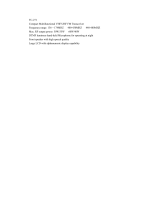
iii
CONTENTS
PREPARATION ................................................................................................ 1
SUPPLIED ACCESSORIES .......................................................................
1
MOBILE INSTALLATION ............................................................................
2
TX/RX Unit Installation ..........................................................................
2
Operation Panel Installation ..................................................................
3
Power Cable Connection ......................................................................
3
FIXED STATION .........................................................................................
4
Operation Panel Installation ..................................................................
4
Power Cable Connection ......................................................................
5
REPLACING FUSES ..................................................................................
6
OPERATION PANEL AND MICROPHONE CONNECTION ......................
6
ANTENNA CONNECTION
.......................................................................... 7
ACCESSORY CONNECTIONS ..................................................................
7
External Speakers ................................................................................. 7
GETTING ACQUAINTED ................................................................................. 8
OPERATION PANEL (FRONT) .................................................................. 8
OPERATION PANEL (REAR & LEFT) ..................................................... 10
DISPLAY ...................................................................................................
12
TX/ RX UNIT REAR PANEL .....................................................................
14
TX/ RX UNIT SUB-PANEL
........................................................................ 14
MICROPHONE (MC-59) ...........................................................................
15
BASIC OPERATIONS .................................................................................... 16
SWITCHING THE POWER ON/ OFF .......................................................
16
ADJUSTING THE VOLUME .....................................................................
16
ADJUSTING THE SQUELCH ................................................................... 17
SELECTING A BAND ...............................................................................
17
SELECTING DUAL BAND MODE/ SINGLE BAND MODE ......................
18
SELECTING A FREQUENCY BAND
........................................................ 19
SELECTING AN OPERATING MODE
...................................................... 20
VFO Mode ........................................................................................... 20
Memory Channel Mode ....................................................................... 21
Call Channel Mode .............................................................................. 21
TRANSMITTING .......................................................................................
22
MENU MODE ................................................................................................. 23
MENU ACCESS .......................................................................................
23
MENU CONFIGURATION ........................................................................
24
CHARACTER ENTRY ..............................................................................
34
OPTIONS ....................................................................................................... 36
MEMORY CONTROL PROGRAM MCP-2A .............................................
36
CONNECTING THE PG-5G/ PG-5H INTERFACE CABLES ....................
37





















